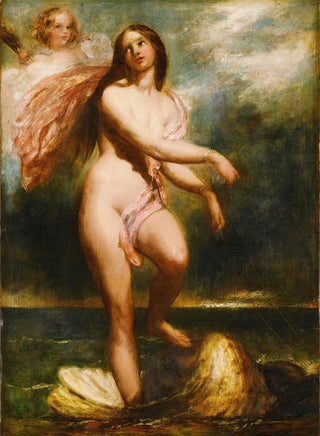Art print | The Birth of Venus - William Etty


View from behind

Frame (optional)
Art print La naissance de Vénus - William Etty – Engaging introduction
In the vibrant universe of art, some works stand out for their ability to capture the collective imagination and evoke deep emotions. "The Birth of Venus" by William Etty is one of these iconic creations, where beauty, sensuality, and mythology converge in a striking visual harmony. This piece, illustrating the goddess of love and beauty emerging from the waves, is a true homage to femininity and the power of nature. Gazing at this scene, the viewer is immediately transported to a world where the sublime and the divine coexist, offering an unforgettable aesthetic experience.
Style and uniqueness of the work
William Etty's style is characterized by an exceptional mastery of color and light, elements that give "The Birth of Venus" an atmosphere that is both ethereal and vibrant. The delicate tones of the goddess's skin, contrasted by the darker shades of the background, create a depth that draws the eye and holds attention. Etty, a true virtuoso, manages to bring his characters to life, making them almost tangible. The composition is carefully orchestrated, with each element precisely placed to enhance the scene's dynamism. The waves surrounding Venus seem to dance around her, while the mythological figures around her add a narrative dimension to the work. This blend of sensuality and delicacy makes this painting an essential masterpiece of British romanticism.
The artist and his influence
William Etty, born in 1787 in York, is often regarded as one of the pioneers of Romantic painting in England. His passion for depicting the human body, especially the female form, led him to explore bold themes throughout his career. Etty was deeply influenced by Renaissance masters such as Titian and Rubens, whose techniques he studied and adapted to his own style. His desire to capture beauty in all its splendor, without compromise, paved the way for a new appreciation of the nude in British art. Through his works, he not only

Matte finish

View from behind

Frame (optional)
Art print La naissance de Vénus - William Etty – Engaging introduction
In the vibrant universe of art, some works stand out for their ability to capture the collective imagination and evoke deep emotions. "The Birth of Venus" by William Etty is one of these iconic creations, where beauty, sensuality, and mythology converge in a striking visual harmony. This piece, illustrating the goddess of love and beauty emerging from the waves, is a true homage to femininity and the power of nature. Gazing at this scene, the viewer is immediately transported to a world where the sublime and the divine coexist, offering an unforgettable aesthetic experience.
Style and uniqueness of the work
William Etty's style is characterized by an exceptional mastery of color and light, elements that give "The Birth of Venus" an atmosphere that is both ethereal and vibrant. The delicate tones of the goddess's skin, contrasted by the darker shades of the background, create a depth that draws the eye and holds attention. Etty, a true virtuoso, manages to bring his characters to life, making them almost tangible. The composition is carefully orchestrated, with each element precisely placed to enhance the scene's dynamism. The waves surrounding Venus seem to dance around her, while the mythological figures around her add a narrative dimension to the work. This blend of sensuality and delicacy makes this painting an essential masterpiece of British romanticism.
The artist and his influence
William Etty, born in 1787 in York, is often regarded as one of the pioneers of Romantic painting in England. His passion for depicting the human body, especially the female form, led him to explore bold themes throughout his career. Etty was deeply influenced by Renaissance masters such as Titian and Rubens, whose techniques he studied and adapted to his own style. His desire to capture beauty in all its splendor, without compromise, paved the way for a new appreciation of the nude in British art. Through his works, he not only






